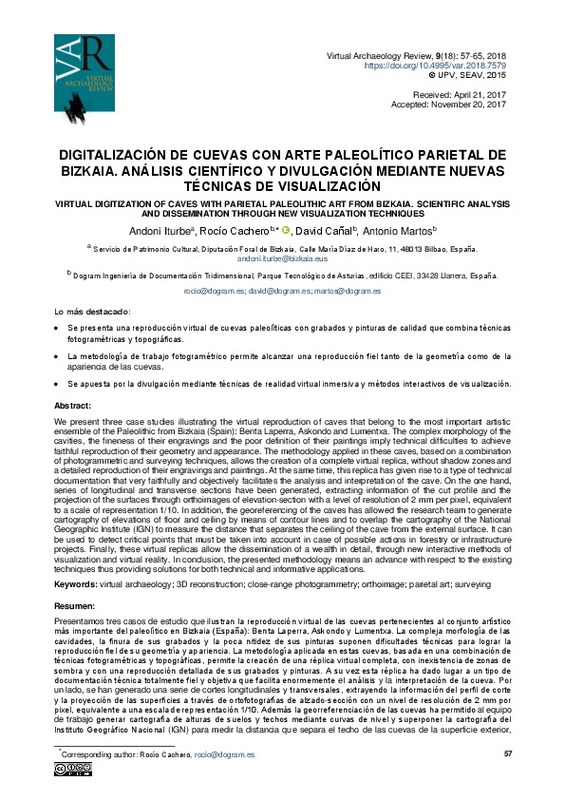JavaScript is disabled for your browser. Some features of this site may not work without it.
Buscar en RiuNet
Listar
Mi cuenta
Estadísticas
Ayuda RiuNet
Admin. UPV
Digitalización de cuevas con arte paleolítico parietal de Bizkaia. Análisis científico y divulgación mediante nuevas técnicas de visualización
Mostrar el registro sencillo del ítem
Ficheros en el ítem
| dc.contributor.author | Iturbe, Andoni
|
es_ES |
| dc.contributor.author | Cachero, Rocio
|
es_ES |
| dc.contributor.author | Cañal, David
|
es_ES |
| dc.contributor.author | Martos, Antonio
|
es_ES |
| dc.date.accessioned | 2018-01-11T09:20:39Z | |
| dc.date.available | 2018-01-11T09:20:39Z | |
| dc.date.issued | 2018-01-10 | |
| dc.identifier.uri | http://hdl.handle.net/10251/94453 | |
| dc.description.abstract | [EN] We present three case studies illustrating the virtual reproduction of caves that belong to the most important artistic ensemble of the Paleolithic from Bizkaia (Spain): Benta Laperra, Askondo and Lumentxa. The complex morphology of the cavities, the fineness of their engravings and the poor definition of their paintings imply technical difficulties to achieve faithful reproduction of their geometry and appearance. The methodology applied in these caves, based on a combination of photogrammetric and surveying techniques, allows the creation of a complete virtual replica, without shadow zones and a detailed reproduction of their engravings and paintings. At the same time, this replica has given rise to a type of technical documentation that very faithfully and objectively facilitates the analysis and interpretation of the cave. On the one hand, series of longitudinal and transverse sections have been generated, extracting information of the cut profile and the projection of the surfaces through orthoimages of elevation-section with a level of resolution of 2 mm per pixel, equivalent to a scale of representation 1/10. In addition, the georeferencing of the caves has allowed the research team to generate cartography of elevations of floor and ceiling by means of contour lines and to overlap the cartography of the National Geographic Institute (IGN) to measure the distance that separates the ceiling of the cave from the external surface. It can be used to detect critical points that must be taken into account in case of possible actions in forestry or infrastructure projects. Finally, these virtual replicas allow the dissemination of a wealth in detail, through new interactive methods of visualization and virtual reality. In conclusion, the presented methodology means an advance with respect to the existing techniques thus providing solutions for both technical and informative applications. | es_ES |
| dc.description.abstract | [ES] Presentamos tres casos de estudio que ilustran la reproducción virtual de las cuevas pertenecientes al conjunto artístico más importante del paleolítico en Bizkaia (España): Benta Laperra, Askondo y Lumentxa. La compleja morfología de las cavidades, la finura de sus grabados y la poca nitidez de sus pinturas suponen dificultades técnicas para lograr la reproducción fiel de su geometría y apariencia. La metodología aplicada en estas cuevas, basada en una combinación de técnicas fotogramétricas y topográficas, permite la creación de una réplica virtual completa, con inexistencia de zonas de sombra y con una reproducción detallada de sus grabados y pinturas. A su vez esta réplica ha dado lugar a un tipo de documentación técnica totalmente fiel y objetiva que facilita enormemente el análisis y la interpretación de la cueva. Por un lado, se han generado una serie de cortes longitudinales y transversales, extrayendo la información del perfil de corte y la proyección de las superficies a través de ortofotografías de alzado-sección con un nivel de resolución de 2 mm por pixel, equivalente a una escala de representación 1/10. Además la georreferenciación de las cuevas ha permitido al equipo de trabajo generar cartografía de alturas de suelos y techos mediante curvas de nivel y superponer la cartografía del Instituto Geográfico Nacional(IGN)para medir la distancia que separa el techo de las cuevas de la superficie exterior, permitiendo detectar puntos críticos a tener en cuenta en las posibles actuaciones de proyectos forestales o de infraestructuras. Finalmente, estas réplicas virtuales permiten dar a conocer al gran público la riqueza en detalle, a través de nuevos métodos interactivos de visualización y realidad virtual. En conclusión, la metodología presentada supone un avance respecto a las técnicas existentes ofreciendo soluciones tanto para aplicaciones técnicas como divulgativas. | es_ES |
| dc.language | Español | es_ES |
| dc.publisher | Universitat Politècnica de València | |
| dc.relation.ispartof | Virtual Archaeology Review | |
| dc.rights | Reconocimiento - No comercial - Sin obra derivada (by-nc-nd) | es_ES |
| dc.subject | Arqueología virtual | es_ES |
| dc.subject | Reconstrucción 3D | es_ES |
| dc.subject | Fotogrametría de objeto cercano | es_ES |
| dc.subject | Ortofotografía | es_ES |
| dc.subject | Arte parietal | es_ES |
| dc.subject | Topografía | es_ES |
| dc.subject | Virtual archaeology | es_ES |
| dc.subject | 3D reconstruction | es_ES |
| dc.subject | Close-range photogrammetry | es_ES |
| dc.subject | Orthoimage | es_ES |
| dc.subject | Parietal art | es_ES |
| dc.subject | Surveying | es_ES |
| dc.title | Digitalización de cuevas con arte paleolítico parietal de Bizkaia. Análisis científico y divulgación mediante nuevas técnicas de visualización | es_ES |
| dc.title.alternative | Virtual digitization of caves with parietal paleolithic art from Bizkaia. Scientific analysis and dissemination through new visualization techniques | es_ES |
| dc.type | Artículo | es_ES |
| dc.date.updated | 2018-01-10T13:35:38Z | |
| dc.identifier.doi | 10.4995/var.2018.7579 | |
| dc.rights.accessRights | Abierto | es_ES |
| dc.description.bibliographicCitation | Iturbe, A.; Cachero, R.; Cañal, D.; Martos, A. (2018). Digitalización de cuevas con arte paleolítico parietal de Bizkaia. Análisis científico y divulgación mediante nuevas técnicas de visualización. Virtual Archaeology Review. 9(18):57-65. https://doi.org/10.4995/var.2018.7579 | es_ES |
| dc.description.accrualMethod | SWORD | es_ES |
| dc.relation.publisherversion | https://doi.org/10.4995/var.2018.7579 | es_ES |
| dc.description.upvformatpinicio | 57 | es_ES |
| dc.description.upvformatpfin | 65 | es_ES |
| dc.type.version | info:eu-repo/semantics/publishedVersion | es_ES |
| dc.description.volume | 9 | |
| dc.description.issue | 18 | |
| dc.identifier.eissn | 1989-9947 |








